Schedule Monthly Genre Dark fantasy | Writer Neil Gaiman | |
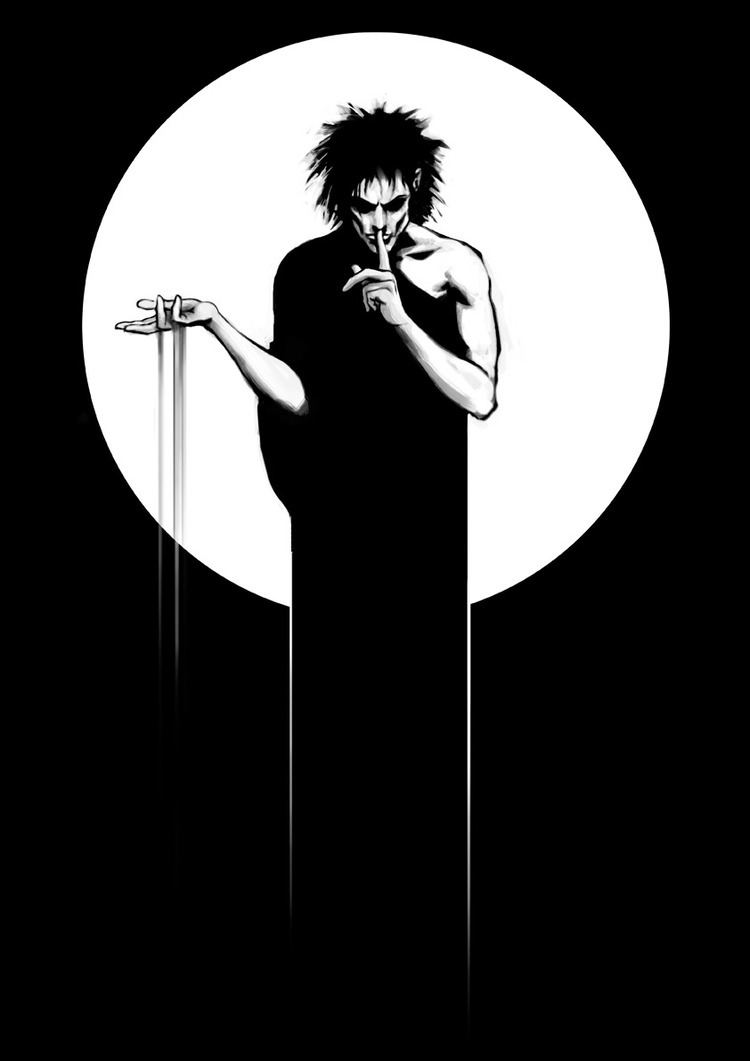 | ||
Publication date The Sandman
January 1989 - March 1996
The Sandman: The Dream Hunters
January 2009 - April 2009
The Sandman: Overture
October 2013 - November 2015 Number of issues The Sandman 75 plus one Special
The Sandman: The Dream Hunters 4
The Sandman: Overture 6 Penciller(s) List
The Sandman
Sam Kieth
Mike Dringenberg
Chris Bachalo
Michael Zulli
Kelley Jones
Charles Vess
Colleen Doran
Matt Wagner
Stan Woch
Bryan Talbot
Shawn McManus
Duncan Eagleson
John Watkiss
Jill Thompson
P. Craig Russell
Alec Stevens
Mike Allred
Shea Anton Pensa
Gary Amaro
Marc Hempel
Glyn Dillon
Dean Ormston
Teddy Kristiansen
Richard Case
Jon J Muth
The Sandman: The Dream Hunters
P. Craig Russell
The Sandman: Overture
J. H. Williams III Inker(s) List
The Sandman
Mike Dringenberg
Malcolm Jones III
Steve Parkhouse
Charles Vess
P. Craig Russell
George Pratt
Dick Giordano
Stan Woch
Shawn McManus
Vince Locke
John Watkiss
Alec Stevens
Mark Buckingham
Mike Allred
Steve Leialoha
Tony Harris
Marc Hempel
D'Israeli
Glyn Dillon
Teddy Kristiansen
Richard Case
Michael Zulli
Jon J Muth
The Sandman: The Dream Hunters
P. Craig Russell
The Sandman: Overture
J. H. Williams III Letterer(s) Todd Klein
John Costanza Awards Eisner Award for Best Writer Publishers DC Comics (1989–1993), Vertigo (1993–) Main characters Death, Dream, Lucifer, Delirium, John Constantine Similar Hellblazer, Fables, Preacher, Watchmen, Transmetropolitan | ||
The Sandman is a comic book series written by Neil Gaiman and published by DC Comics imprint Vertigo. Its artists include Sam Kieth, Mike Dringenberg, Jill Thompson, Shawn McManus, Marc Hempel, and Michael Zulli, with lettering by Todd Klein and covers by Dave McKean. Beginning with issue No. 47, it was placed under the Vertigo imprint. It tells the story of Dream of the Endless, who rules over the world of dreams. The original series ran for 75 issues from January 1989 to March 1996, with Gaiman's contract stipulating that the series would end when he left it.
Contents
- Creation
- Original series
- Additions and spin offs
- Summary
- Themes and genre
- Collected editions
- The Sandman library
- Absolute editions
- Annotated editions
- Omnibus edition
- Reception and legacy
- Film
- Television
- Lucifer
- References
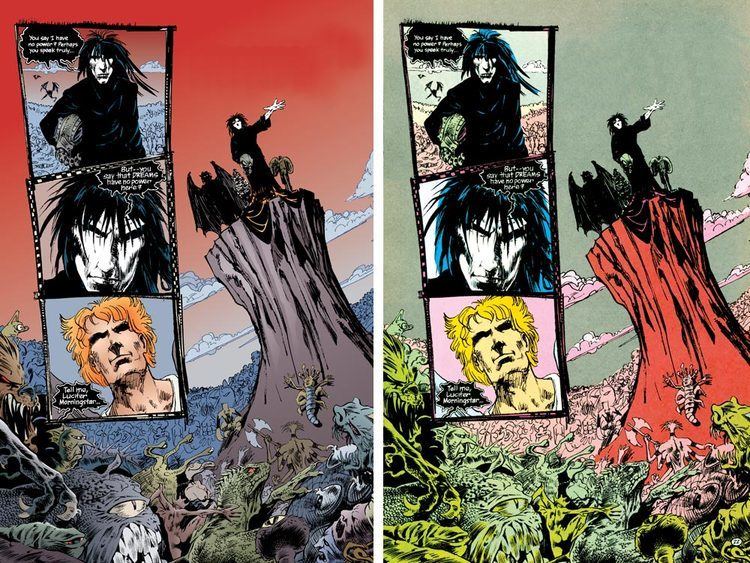
The main character of The Sandman is Dream, also known as Morpheus and other names, who is one of the seven Endless. The other Endless are Destiny, Death, Desire, Despair, Delirium–who was once Delight–and Destruction–who turned his back on his duties. The series is famous for Gaiman's trademark use of anthropomorphic personification of various metaphysical entities, while also blending mythology and history in its horror setting within the DC Universe. The Sandman is a story about stories and how Morpheus, the Lord of Dreams, is captured and subsequently learns that sometimes change is inevitable. The Sandman was Vertigo's flagship title, and is available as a series of ten trade paperbacks, a recolored five-volume Absolute hardcover edition with slipcase, in a black-and-white Annotated edition, and is available for digital download. Critically acclaimed, The Sandman was one of the first few graphic novels ever to be on the New York Times Best Seller list, along with Maus, Watchmen and The Dark Knight Returns. It was one of five graphic novels to make Entertainment Weekly's "100 best reads from 1983 to 2008," ranking at No. 46. Norman Mailer described the series as "a comic strip for intellectuals." The series is noted for having a large influence over the fantasy genre and graphic novel medium since then.

Various film and television versions of Sandman have been developed unsuccessfully since the 1990s. In a panel at the San Diego Comic-Con International in 2007, Gaiman remarked that "[he'd] rather see no Sandman movie made than a bad Sandman movie." In 2013, Warner Bros. announced that David S. Goyer will be producing a film adaptation of the comic book series with Joseph Gordon-Levitt within its upcoming Vertigo film slate. Gordon-Levitt dropped out on March 5, 2016, after Eric Heisserer was brought on as screenwriter.
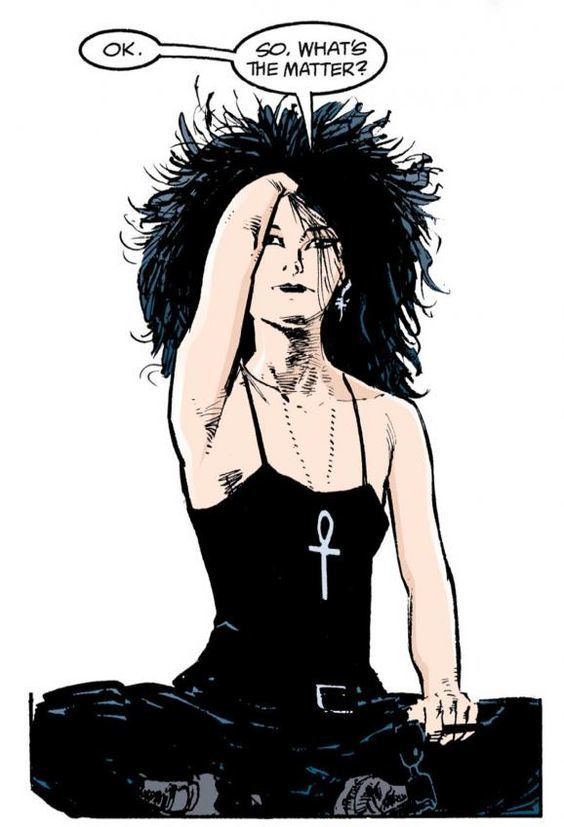
Creation

The Sandman grew out of a proposal by Neil Gaiman to revive DC's 1974–1976 series The Sandman, illustrated by Jack Kirby and Ernie Chua and written by Joe Simon and Michael Fleisher. Gaiman had considered including characters from the "Dream Stream" (including the Kirby Sandman, Brute, Glob, and the brothers Cain and Abel) in a scene for the first issue of his 1988 miniseries Black Orchid. While the scene did not make it into later drafts because Roy Thomas was using the characters in Infinity, Inc., Gaiman soon began constructing a treatment for a new series. Gaiman mentioned his treatment in passing to DC editor Karen Berger. While months later Berger offered Gaiman a comic title to work on, he was unsure his Sandman pitch would be accepted. Weeks later, Berger asked Gaiman if he was interested in doing a Sandman series. Gaiman recalled, "I said, 'Um ... yes. Yes, definitely. What's the catch?' [Berger said,] 'There's only one. We'd like a new Sandman. Keep the name. But the rest is up to you.'"
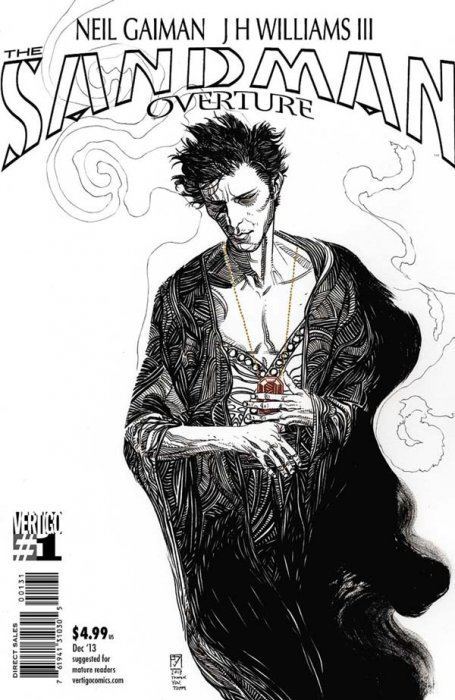
Gaiman crafted the new character from an initial image of "a man, young, pale and naked, imprisoned in a tiny cell, waiting until his captors passed away ... deathly thin, with long dark hair, and strange eyes." Gaiman patterned the character's black attire on a print of a Japanese kimono as well as his own wardrobe. Gaiman wrote an eight-issue outline and gave it to Dave McKean and Leigh Baulch, who drew character sketches. Berger reviewed the sketches (along with some drawn by Gaiman) and suggested Sam Kieth as the series' artist. Mike Dringenberg, Todd Klein, Robbie Busch, and Dave McKean were hired as inker, letterer, colorist, and cover artist, respectively. McKean's approach towards comics covers was unconventional, for he convinced Berger that the series's protagonist did not need to appear on every cover.
Original series
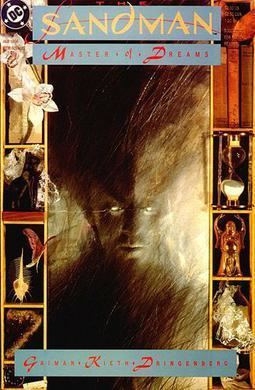
The debut issue of The Sandman went on sale November 29, 1988 and was cover-dated January 1989. Gaiman described the early issues as "awkward", since he, as well as Kieth, Dringenberg, and Busch, had never worked on a regular series before. Kieth quit after the fifth issue; he was replaced by Dringenberg as penciler, who was in turn replaced by Malcolm Jones III as inker. Dave McKean was the cover artist for the series through its entire run.
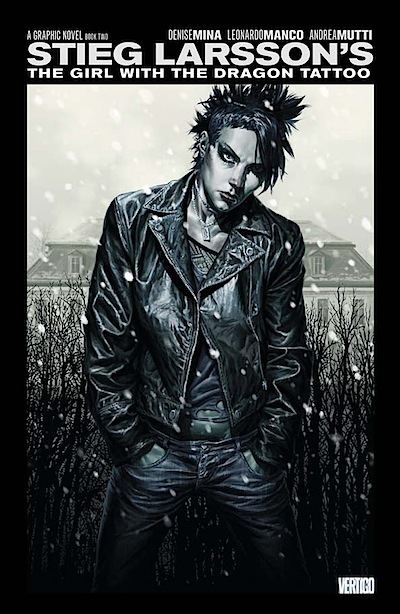
The character then appeared in two of DC's "Suggested for Mature Readers" titles. In Swamp Thing vol. 2 No. 84 (March 1989), Dream and Eve allow Matthew Cable to live in the Dreaming, because he died there, resurrecting him as a raven. He then meets John Constantine in Hellblazer No. 19 leading into the latter's guest appearance in Sandman No. 3 (March 1989).
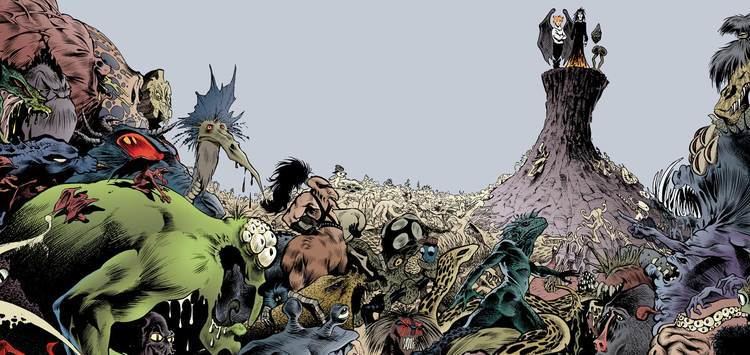
Gaiman revisited Hell as depicted by Alan Moore in Swamp Thing, beginning with a guest appearance by Jack Kirby's Etrigan the Demon in issue No. 4 (April 1989). The story introduces Hell's Hierarchy (as their entry is titled in Who's Who in the DC Universe), headed by Lucifer (who would spin off into his own series in 1999), Beelzebub (later adversary to Kid Eternity), and Azazel, whom Dream defeated later in the series. Dream visited the Justice League International in the following issue, No. 5 (May 1989). Although DC superheroes appeared in the series as late as issue No. 72 (November 1995), this would not be the norm. Gaiman and artist Mike Dringenberg introduced Death, the older sister of Dream, in issue No. 8 (August 1989).
Gaiman began incorporating elements of the Kirby Sandman series in issue No. 11 (December 1989), including the changes implemented by Roy Thomas. Joe Simon and Michael Fleisher had treated the character, who resembled a superhero, as the "true" Sandman. The Thomas and Gaiman stories revealed that the character's existence was a sham created by two nightmares who had escaped to a pocket of the Dreaming. Brute and Glob would later attempt this again on Sanderson Hawkins, sidekick to Wesley Dodds, the Golden Age Sandman. Gaiman gave Jed Walker a surname and made him related to several new characters. The Thomas Sandman was Hector Hall, who married the already-pregnant Fury in the Dreaming in Infinity, Inc. No. 51. It was explained that Dr. Garrett Sanford, the 1970s Simon and Kirby version of the Sandman, had gone insane from the loneliness of the Dream Dimension and taken his own life. Brute and Glob put the spirit of Hector Hall, which had been cast out of his own body into Sanford's body, and it eventually began to resemble Hall's. Fury, in her civilian guise as Lyta Hall was the only superhero recurring character in the series. Even at that, her powers had come to her via the Fury Tisiphone, and the Furies, under the euphemism, "the Kindly Ones", a translation of "Eumenides", a name they earned during the events of Aeschylus's Oresteia trilogy, are major characters in the series.
The series follows a tragic course in which Dream, having learned a great deal from his imprisonment, tries to correct the things he has done wrong in the past. Ultimately, this causes him to mercy kill his own son, which leads to his own death at the hands of the Furies. Dream, having found himself a replacement early on in Daniel Hall, dies in issue No. 69 (July 1995). The remaining issues deal with Dream's funeral, Hob Gadling choosing to remain immortal in spite of Dream's death, and two stories from the past. The series wraps with the story of William Shakespeare creating his other commission for Dream, The Tempest, his last work not in collaboration with other writers.
The Sandman became a cult success for DC Comics and attracted an audience unlike that of mainstream comics: much of the readership was female, many were in their twenties, and many read no other comics at all. Comics historian Les Daniels called Gaiman's work "astonishing" and noted that The Sandman was "a mixture of fantasy, horror, and ironic humor such as comic books had never seen before." DC Comics writer and executive Paul Levitz observed that "The Sandman became the first extraordinary success as a series of graphic novel collections, reaching out and converting new readers to the medium, particularly young women on college campuses, and making Gaiman himself into an iconic cultural figure." Gaiman had a finite run in mind for the series, and it concluded with issue No. 75. Gaiman said in 1996, "Could I do another five issues of Sandman? Well, damn right. And would I be able to look at myself in the mirror happily? No. Is it time to stop because I've reached the end, yes, and I think I'd rather leave while I'm in love." The final issue, No. 75, was dated March 1996.
Additions and spin-offs
The Sandman has inspired numerous spin-offs. While most of these are not written by Gaiman, he did write two miniseries focusing on the character of Death. Death: The High Cost of Living was published from March 1993 to May 1993 and was based around the fable that Death takes human form once a century, to remain grounded and in touch with humanity. This was followed in 1996 by Death: The Time of Your Life, featuring the characters of Foxglove and Hazel from A Game of You. Other spin-offs include The Dreaming, Lucifer and Dead Boy Detectives.
A set of Sandman trading cards was issued in 1994 by SkyBox International.
In 1999, Gaiman wrote The Sandman: The Dream Hunters, a novella illustrated by Yoshitaka Amano. As in many of the single-issue stories throughout The Sandman, Morpheus appears in Dream Hunters, but only as a supporting character. In Gaiman's afterword to the book, he describes the story as a retelling of an existing Japanese legend. There is no trace of it in the primary source he cites, and when asked, Gaiman has stated that he made up the "legend". The novel was later adapted into a four-issue miniseries by P. Craig Russell and released by Vertigo from January 2009 to April 2009.
Gaiman and Matt Wagner co-wrote Sandman Midnight Theatre, a 1995 prestige format one-shot in which Dream and Wesley Dodds meet in person after the events in the storyline, "The Python," which ended with Dodds's lover, Dian Belmont, going to England, which eventually brings both her and Dodds to Roderick Burgess's mansion. In 2001, Dream appeared in a flashback in Green Arrow vol. 3, No. 9, which takes place at a point during the 70 years of the first issue.
Gaiman wrote several new stories about Morpheus and his siblings, one story for each, which were published in 2003 as the Endless Nights anthology. The stories are set throughout history, but two take place after the final events of the monthly series. It was written by Gaiman and featured a different illustrator for each story. This collection was the first hardcover graphic novel ever to appear on the New York Times Hardcover Best Seller list.
Writer/artist Jill Thompson wrote and illustrated several stories featuring the Sandman characters. These include the manga-style book Death: At Death's Door, one of DC's best selling books of 2003, set during the events of Season of Mists, and The Little Endless Storybook, a children's book using childlike versions of the Endless.
To commemorate the twenty-fifth anniversary of The Sandman, Gaiman wrote a new tale involving the battle that had exhausted Morpheus prior to the beginning of the original story. Written by Gaiman and with art by J. H. Williams III, Overture tells the previously hinted story of Dream's adventure prior to Preludes and Nocturnes, which had exhausted him so much that it made Burgess' actions capable of capturing him. The limited series had six issues. Issue #1 was released on October 30, 2013, and although it was planned to have a bi-monthly release schedule, issue 2 was delayed until March 2014, which Gaiman explained was "mostly due to the giant signing tour I was on from June, and me not getting script written on the tour, with knock-on effects". Special editions were released approximately a month after the original editions, which contain interviews with the creative team, alongside rare artwork.
Summary
The Sandman's main character is Dream, the titular Sandman, also known to various characters throughout the series as Morpheus, Oneiros, the Shaper, the Shaper of Form, Lord of the Dreaming, the Dream King, Dream-Sneak, the Cat of Dreams, Murphy, Kai'ckul and Lord L'Zoril, who is the anthropomorphic personification of dreams. At the start of the series, Morpheus is captured by an occult ritual and held prisoner for 70 years. Morpheus escapes in the modern day and, after avenging himself upon his captors, sets about rebuilding his kingdom, which has fallen into disrepair in his absence. The character's initial haughty and often cruel manner begins to soften after his years of imprisonment at the start of the series, but the challenge of undoing past sins and changing old ways is an enormous one for a being who has been set in his ways for billions of years. In its beginnings, the series is a very dark horror comic. Later, the series evolves into an elaborate fantasy series, incorporating elements of classical and contemporary mythology, ultimately placing its protagonist in the role of a tragic hero.
The storylines primarily take place in the Dreaming, Morpheus's realm, and the waking world, with occasional visits to other domains, such as Hell, Faerie, Asgard, and the domains of the other Endless. Many use the contemporary United States of America and the United Kingdom as a backdrop. The DC Universe was the official setting of the series, but well-known DC characters and places were rarely featured after 1990. A notable exception is Lyta Hall, formerly Fury of the 1980s super-team Infinity, Inc., who figures prominently in the "Kindly Ones" story arc, and her superhuman abilities are not ignored. Most of the storylines take place in modern times, but many short stories are set in the past, taking advantage of the immortal nature of many of the characters, and deal with historical individuals and events such as in the short story "Men of Good Fortune."
Themes and genre
The Sandman comic book series falls within the dark fantasy genre, albeit in a more contemporary and modern setting. Critic Marc Buxton described the book as a "masterful tale that created a movement of mature dark fantasy" which were largely unseen in previous fantasy works before it. The comic book also falls into the genres of urban fantasy, epic fantasy, historical drama, superhero, and is written as a metaphysical examination of the elements of fiction, in which Neil Gaiman accomplished through the artistic use of unique anthropomorphic personifications, mythology, legends, historical figures and occult culture, making up most of the major and minor characters as well as the plot device and even the settings of the story. In its earliest story arcs, the Sandman mythos existed primarily in the DC Universe, and as such numerous DC characters made some appearances or were mentioned. The series would later move away from referencing the DCU, but still exists in the same universe nonetheless.
Critic Hilary Goldstein described the comic book as "about the concept of dreams more so than the act of dreaming." In the early issues, responsibility and rebirth were the primary themes of the story. As Dream finally liberates himself from his occultist captors, he returns to his kingdom which had fallen on hard times due to his absence, while also facing his other siblings, who each have their own reaction to his return. The story is structured not as a series of unconnected events nor as an incoherent dream, but by having each panel have a specific purpose in the flow of the story. Dreams became the core of every story arc written in the series, and the protagonist's journey became more distinct and deliberate. Many Vertigo books since, such as Transmetropolitan and Y: The Last Man, have adopted this kind of format in their writing, creating a traditional prose only seen in the imprint.
Collected editions
The Sandman was initially published as a monthly serial, in 32-page comic books with some exceptions to this pattern. The stories within were usually 24 pages long, with eight exceptions within the main story arc: issue #1, "Sleep of the Just" (40 pages); issue #14, "Collectors" (38 pages); issue #32, "Slaughter on Fifth Avenue" (25 pages); issue #33, "Lullabies of Broadway" (23 pages); issue #36, "Over the Sea to Sky" (39 pages); issue #50, "Distant Mirrors—Ramadan" (32 pages); issue #52, "Cluracan's Tale" (25 pages); issue #75, "The Tempest" (38 pages). As the series increased in popularity, DC Comics began to reprint them in hardcover and trade paperback editions, each representing either a complete novel or a collection of related short stories.
DC first published "The Doll's House" storyline in a collection called simply The Sandman. Shortly thereafter, the first three volumes were published and named independently and collected in an eponymous boxed set. (Death's debut story, "The Sound of Her Wings" from issue #8, appeared both at the beginning of early editions of The Doll's House and at the end of Preludes and Nocturnes, creating overlap between the first two volumes. In 1998, the cover images from The Sandman were released as one compiled volume titled Dustcovers: The Collected Sandman Covers. Dave McKean's covers use techniques such as painting, sculpture, photography, drawing, and computer manipulation.
The Sandman library
A total of ten trade paperbacks contain the full run of the series and have all been kept in print. In 2010, Vertigo began releasing a new edition of Sandman books, featuring the new coloring from the Absolute Editions.
The Sandman, written by Neil Gaiman and illustrated by J. H. Williams III, returned in October 2013 as a limited series. The six-part prequel, Overture, tells the previously untold story that lead to Morpheus' capture by Roderick Burgess in the first issue of the monthly series.
Absolute editions
The DC Comics Absolute Edition series are large 8" by 12" prints of a considerably higher quality and price than the library edition, and include a leather-like cover and a slipcase. Many of the early stories have been extensively retouched and/or recolored with Gaiman's approval.
The first volume of The Absolute Sandman was published in November 2006; it collected the first 20 issues (Preludes and Nocturnes, The Doll's House, and Dream Country). The volume features a copy of the original series outline and other bonus features, such as a new introduction by the president of DC Comics, a new afterword, and a reproduction of the original comic draft and notes for "A Midsummer Night's Dream". In promotion of this reissuing, DC issued a refurbished edition of the first issue of the series.
Annotated editions
While initially hesitant about releasing annotated editions, Gaiman eventually changed his mind when he forgot a reference when asked about it by a reader. The task of annotating the series was undertaken by Gaiman's friend Leslie S. Klinger of The New Annotated Sherlock Holmes who worked from the original scripts given to him by Gaiman.
The first volume of The Annotated Sandman was published by DC Comics in January 2012 as a large 12" by 12" black-and-white book with an introduction by Gaiman and included issues #1-20. The annotations are presented on a page-by-page, panel-by-panel basis, with quoted sections from Gaiman's scripts and insight into the various historical, mythological and DC Universe references included in the comic. The second volume annotating issues #21-39 was released in November 2012. The third volume covering issues #40-55, The Sandman Special No. 1 and the story "How They Met Themselves" from Vertigo: Winter's Edge #3 was released in October 2014. The fourth volume including issues #57-75 and the story "The Castle" from Vertigo Jam #1 was released in December 2015.
The first volume was nominated for the 2012 Bram Stoker Award for Best Non-Fiction.
Omnibus edition
The Sandman Omnibus, a massive two-volume hardcover edition, was released in 2013 to commemorate the 25th anniversary of The Sandman. Volume 1 collects issues #1-37 and The Sandman Special No. 1 with Volume 2 collecting issues #38-75 with stories from Vertigo Jam No. 1 and Vertigo: Winter's Edge. Both volumes are printed with the Absolute edition recoloring, feature a leather-like cover in black and red, and have over 1000 pages.
A special Silver version of The Sandman Omnibus was released as well. Limited to 500 copies and autographed by Gaiman, the Silver edition includes both volumes with a slipcase, silver-like finish and a numbered page with Gaiman's signature.
Reception and legacy
The Sandman No. 19, "A Midsummer Night's Dream", won the World Fantasy Award in 1991 for Best Short Fiction. The Sandman and its spin-offs have won more than 26 Eisner Awards, including three for Best Continuing Series, one for Best Short Story, four for Best Writer (Neil Gaiman), seven for Best Lettering (Todd Klein), and two for Best Penciller/Inker (one each for Charles Vess and P. Craig Russell). The Sandman: The Dream Hunters was nominated for the Hugo Award for Best Related Book in 2000. The Dream Hunters and Endless Nights won the Bram Stoker Award for Best Illustrated Narrative in 1999 and 2003, respectively. That same year, Season of Mists won the Angoulême International Comics Festival Prize for Scenario. In 2005, IGN declared The Sandman as the best Vertigo comic ever.
Hillary Goldstein of IGN praised the comic book, saying that it "is truly the cream of the crop when it comes to Vertigo books. Neil Gaiman's work on the series is considered legendary for a reason. This story, in its entirety, is every bit as good as Watchmen and of equal (if not greater) literary merit. Were I to list the 100 best single comic-book issues I have ever read, three would come from this collection. Whether you have read The Sandman before or are a first timer, this is the one book you need to buy this fall. The stories within are magnificent and the care taken in reproducing Gaiman's work is the same you'd expect for any great work of literature."
Film
Throughout the late 1990s, a film adaptation of the comic was periodically planned by Warner Bros., parent company of DC Comics. Roger Avary was originally attached to direct after the success of Pulp Fiction, collaborating with Pirates of the Caribbean screenwriters Ted Elliott and Terry Rossio in 1996 on a revision of their first script draft, which merged the "Preludes and Nocturnes" storyline with that of "The Doll's House." Avary intended the film to be in part visually inspired by animator Jan Švankmajer's work. Avary was fired after disagreements over the creative direction with executive producer Jon Peters, best known for Batman and Superman Lives. It was due to their meeting on the Sandman film project that Avary and Gaiman collaborated one year later on the script for Beowulf. The project carried on through several more writers and scripts. A later draft by William Farmer, reviewed at Ain't It Cool News, was met with scorn from fans. Gaiman called the last screenplay that Warner Bros. would send him "not only the worst Sandman script I've ever seen, but quite easily the worst script I've ever read." Gaiman has said that his dissatisfaction with how his characters were being treated had dissuaded him from writing any more stories involving the Endless, although he has since written Endless Nights.
By 2001, the project had become stranded in development hell. In a Q&A panel at Comic-Con 2007, Gaiman remarked, "I'd rather see no Sandman movie made than a bad Sandman movie. But I feel like the time for a Sandman movie is coming soon. We need someone who has the same obsession with the source material as Peter Jackson had with Lord of the Rings or Sam Raimi had with Spider-Man." That same year, he stated that he could imagine Terry Gilliam as a director for the adaptation: "I would always give anything to Terry Gilliam, forever, so if Terry Gilliam ever wants to do Sandman then as far as I'm concerned Terry Gilliam should do Sandman." In 2013, DC President Diane Nelson says that a Sandman film will be as rich as the Harry Potter universe. David S. Goyer announced in an interview in early December that he will be producing an adaptation of the graphic novel, alongside Joseph Gordon-Levitt and Neil Gaiman. Jack Thorne has been hired to write the script. On October 16, 2014, Gaiman clarified that while the film was not announced with the DC slate by Warner Bros., that the film will be distributed by Vertigo and will be announced with those slate of films. Goyer told Deadline.com in an interview that the studio is very happy with the film's script. According to Deadline.com, the film will be distributed by New Line Cinema. In October 2015, Goyer revealed that a new screenwriter was being brought on board to revise the script by Jack Thorne and stated that he believes the film will go into production next year. In March 2016, The Hollywood Reporter has reported that Eric Heisserer will be writing the film's script. The next day, Gordon-Levitt announced that he dropped out due to disagreements with the studio over the film. On November 9, 2016, i09 reports that Heisserer has turned in his draft of the script but left the film stating that the film should be an HBO series.
Television
Due to the prolonged development period of the film, in 2010, DC Entertainment shifted focus onto developing a television series adaptation. Film director James Mangold pitched a series concept to cable channel HBO, whilst consulting with Gaiman himself on an unofficial basis, but this proved to be unsuccessful. It was reported in September 2010 that Warner Bros. Television was licensing the rights to produce a TV series, and that Supernatural creator Eric Kripke was their preferred candidate to adapt the saga. In March 2011, it was announced via Neil Gaiman's web blog that while he and DC liked Eric Kripke and his approach, it didn't feel quite right. The author hoped to launch the series in another form but plans for a television adaptation are on hold as production moves forward on the film. As the film adaptation of Morpheus' story were being planned, DC and Fox discussed in September about a possible TV series based on the Sandman character Lucifer.
Lucifer
On September 16, 2014, Deadline.com reported that DC and Fox were developing a television series based on the Sandman character Lucifer created by Neil Gaiman. On February 19, 2015, the official pilot order was given. According to the premise reported by The Hollywood Reporter, the potential series will greatly differ from the comic book version of the character featured in the Sandman and his own solo comic book series. Lucifer will be featured in a CSI-like or Elementary style television show with supernatural elements.
On February 27, 2015, Newsarama reported that Rush and Once Upon A Time actor Tom Ellis was cast as Lucifer Morningstar. The writer of the pilot episode will be Tom Kapinos and the director and executive producer will be Underworld director, Len Wiseman. The role of Maze had to be recast. CSI actress Lina Esco was originally cast as Maze but was replaced by Lesley-Ann Brandt. In May 2015, the series was officially picked up.
